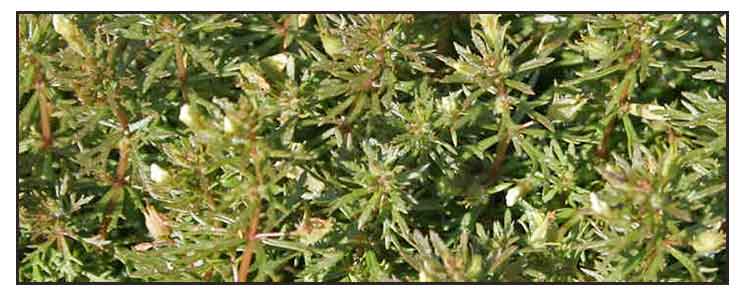 Botany Botany
Tara-tara is a small, gregarious, smooth, submerged or partly submerged, aquatic herb 10 to 20 centimeters in height, and exceedingly variable in its vegetative characters. Stems are slender, erect, simple, or diffusely branched. Leaves are in whorls, pinnatifid, and 6 to 18 millimeters long. Leaves under water are opposite. Flowers are pale purple or pale violet, and borne singly in the axils of the leaves. Calyx is 3 to 4 millimeters long, rarely larger, and hemispheric in fruit, with ovate lobes. Corolla is 10 to 12 millimeters long.
Distribution
- In shallow, slow streams at low and medium altitudes, ascending to 1,500 meters.
- Found in Cagayan, Ilocos Norte, Bontoc, Benguet, Pangasinan, Nueva Ecija, Rizal and Laguna Provinces in Luzon; in Leyte; and in Bukidnon, Davao and Lanao Provinces in Mindanao.
- Also occurs in India to Japan and through Malaya to tropical Australia.
Constituents
- Study of whole plant yielded two flavonoids, (2S)-5,7,3′,4′-tetramethoxyflavanone and 5,7,2′,5′-tetramethoxyflavone, together with three known flavonoids, 7-O-methylwogonin, skullcapflavone I and 5-hydroxy-7,2′-dimethoxyflavone. (1)
- Study of roots and aerial parts yielded two flavonoids, 5,6-dihydroxy-7,8,4'-trimethoxy flavone (1) and 5,2'-dihydroxy-8,3',4'-trimethoxyflavone (2) together with three known compounds, 5-hydroxy-7,2'-
dimethoxyflavone (3), 5,2'-dihydroxy-7,8-dimethoxyflavone (4), and ß-sitosterol (5).
(4)
- A hexane extract of the aerial parts and roots of Limnophila indica yielded a new flavone, 3',4'-ethyl- enedioxy-5-hydroxy-3-(1-hydroxy-1-methylethyl)-6,7-dimethyl-5'-methoxyflavone-8-carboxylic acid.
- Study yielded 26 chemical constituents consisting of flavonoids, terpenoids, and amino acids. Essential oil constituents were D-limonene (13) and D-perillaldehyde (14). Amino acids from the leaves were alanine (15), glycine (16), serine (17), glutamic acid (18), aspartic acid (19), cystine (20), leucine (21), valine (22), threonine (23), histidine (24), tyrosine (25), and arginine (26). (see study below) (9)
- Study of petrol extract of aerial parts and roots yielded a new flavone, 5-hydroxy-6,8-dimethoxy-3,4'-
methylenedioxyflavone. (13)
- Preliminary screening of aerial parts yielded alkaloids, flavonoids, tannins, terpenoids, glycosides, and sugars. (see study below) (15)
Properties
- Agreeable and refreshing odor of fresh plant resembles camphor oil or oil of lemon.
- Considered antiseptic, carminative.
Parts used
Leaves, plant juice.
Uses
Folkloric
- In the Philippines, infusion of leaves used for dysentery and dyspepsia.
- Juice of the plant is rubbed over the body in pestilent fevers.
- Liniment made from the plant with coconut oil is used in elephantiasis.
- Internally the juice, combined with cumin and other aromatics, is given for dysentery.
- In traditional Indian medicine, used in treatment of pestilent fever, dysentery, and elephantiasis. Plant liniment in coconut oil rubbed over the body in pestilent fever. Used internally, mixed with ginger, cumin, and other aromatics, for dysentery. (9) Juice of aerial parts mixed with cumin and ginger applied to cuts and wounds as antiseptic. (11)
- In Odisha, India, leaf juice taken for burning urination. (10)
Studies
• Flavanoids: Study of whole plant yielded two flavonoids, (2S)-5,7,3′,4′-tetramethoxyflavanone and 5,7,2′,5′-tetramethoxyflavone, together with three known flavonoids, 7-O-methylwogonin, skullcapflavone I and 5-hydroxy-7,2′-dimethoxyflavone. (1)
• Flavanoids: Aerial parts and roots yielded a flavonoid - 5,2'-Dihydroxy-8,3',4'-trimethoxyflavone, 5,8-Dihydroxy-6,7,4'-trimethoxyflavone
• Cytotoxicity / Breast Cancer Cell: In a study investigating the cytotoxic effect of 16 Bangladesh medicinal plant extracts, Limnifolia indica's aqueous extract showed no toxicity against healthy mouse fibroblast but selective cytotoxicity against breast cancer cells. (2)
• Antimicrobial: L. indica extract was found to inhibit the growth of Xanthomas campestris and X. malvacearum in vitro.
• Antibacterial / Antidiarrheal / Inhibitory Effect on Shigellosis: Study of whole plant extract yielded phenolic compounds, flavonoids, alkaloids, fats, and oils. It showed potent antibacterial activity against four bacterial strains and exhibited powerful antibacterial effect against antibiotic-resistant Shigella species. It also showed dose-dependent in vivo antidiarrheal activity, with a result superior to loperamide. In vitro antacid activity showed mild activity. Results suggest an eminent substitute as anti-dysentery and antidiarrheal agent. (6)
• Cytotoxicity / Human Cancer Cell Lines: An aqueous extract was found inactive against normal mouse fibroblast cells and adenocarcinoma cells but active against gastric adenocarcinoma cells and breast ductal carcinoma cells with IC50 of 2.24 and 1.25 mg/mL, respectively. A methanol extract showed moderate activity against normal mouse fibroblast cells and gastric adenocarcinoma (IC 50 >2.5 mg/mL) and potent activity against colorectal carcinomal cells and breast ductal carcinoma cells having IC50 value of 2.19 and 1.24 mg/mL, respectively. (see constituents above) (9)
• Pentacyclic Triterpene / Potent Antibacterial Activity / Aerial Parts and Roots: Study isolated a new pentacyclic triterpenoid constituent, 3-0x0-olean-12(13),18(19)-dien-29α-carboxylic acid. The compound exhibited considerable antibacterial activity against three gram-positive bacteria viz., B. subtilis, S. aureus, L. monocytogenes with MIC range of 25-30 µg/ml and moderate activity against four gram-negative bacteria viz., S. typhimurium, E. coli, P. aeruginosa, and Pantoea ananatis with MIC range of 30-100 µg/ml. Upon compound treatment, B. subtilis and P. aeruginosa released nucleic acid suggesting probably action on the cell membrane. (12)
• Flavonoids / Antimicrobial: Study isolated two bioflavonoids, i.e., 5-7-dihydroxy-4',6,8-trimethoxyflavone (1) and 5,6-dihydroxy-4',7,8-trimethoxyflavone (2) from Limnophila heterophylla and L. indica, respectively. The compounds showed moderate and broad antimicrobial activities against both Gram-positive and Gram-negative bacteria and against fungal pathogens. Compound 1 showed bactericidal effect against E. coli and S. aureus while compound 2 showed effective kill of B. subtilis by cell lysis. (14)
• Hepatoprotective / Paracetamol and Ethanol Toxicities / Aerial Parts: Study evaluated the hepatoprotective activity of leaves of L. indica against paracetamol and ethanol induced liver damage in Wistar rats using silymarin as standard. Results showed hepatoprotective activity attributed to the presence of flavanoids via activation of regeneration of hepatocytes that restored the structural and functional integrity of the liver. (15)
Availability
Wild-crafted.
|

![]()




